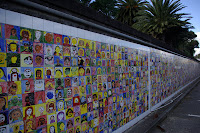The Simple to Sumptuous exhibition at the National Library Gallery had a plethora of books spanning the disciplines of art, literature, communications, economics and sociology. This collection of books ranges from the elaborate to the simple. Once again it inspired me to poetry as I wondered would you judge a book by its cover; well, would you? There is a book written on Shackleton's expedition to Antrarctica, bound in 1908 in wooden boards from packing cases of whatever came to hand - in this case it was a crate of beans. It is hardly a glamorous binding for the writings about and drawings of one of the most fragile ecosystems on the planet.Another is a work by Dante Gabrielle Rossetti - his ballads and sonnets are bound with a cover from 1881. The beige silk cloth with mesh of gold thread is oversewn with flowers and leaves in imitation of the Rossetti designed cover of the standard edition. When Rossetti's wife died from overuse of laudanum, he buried the poems he had been working on in her coffin. Years later he tried to recall them, but found he couldn't - his own mind was addled with chloral hydrate by now - and so the Pre Raphaelite Brotherhood, to which he belonged, encouraged him to dig them up and publish them: love sonnets from beyond the grave.
Tiny devotional books of the Tudor and Stuart period with canvas bindings, were embroidered with gold and silver thread, and bound with a common lower board so the volumes are upside down to each other, facing opposite directions. They are fragile now due to overuse and are practically falling apart - they have become dilapidated or looted for their thread.
In a glut of excess, the bookbinders Sangorski and Sutcliffe of London were famous for their use of coloured leathers, gold and semi-precious stones. They created The Great Omar, which was a version of the Rubaiyat of Omar Khayyam. It took two years of continuous work to make and featured 1,500 separate pieces of leather, 1,050 jewels and heavy gold tooling.
It was lost on the sinking of the Titanic. A copy was made, but this was destroyed in World War II during the Blitz. With no disrespect to the great Omar Khayyam and his fantastic living in the moment philosophy ('A loaf of bread, a jug of wine, and thou'), the story of this cover may be as great as its contents and demands to be told.
Hidden Treasures
1.
What’s in the box?
Tales of adventure; feats of heroism;
Sheaves of botanical images
And mystical wisps of ethereal light
From the ends of the earth
Crates of beans
Natural fibre to fuel expeditions
At the end of an era
And feed the soul with half-told truths
Now frozen in time.
2.
Tenderly traced in threads of gold
Flowers and leaves burst from beige silk
The mesh shot with dreams made flesh
Through post-coital lovers and chloral hydrate.
Tendrils weaving through clods of earth
Buried with flowing tresses.
The rotting notebook of a painter poet;
Renaissance through Brotherhood.
3.
Miniature acts of devotion for Tudors and Stuarts
Where Transubstantiation means death
In the wrong hands.
Thumb-worn and dog-eared; His Masters Voice is
Closeted in confessional, dancing dos-a-dos,
Sleeping head to toe.
Pillaged for their precious thread; dilapidated and
Abandoned to the ravages of times
Fragile as faith.
4.
Jewels and stones may break my bones
But words will live forever.
Beneath the waves or blitzed cities
Rumours of hidden treasure.
Forget the gold, coloured leather,
Years of continuous strife;
Just be happy for this moment,
For this moment is your life.
 In my last post from my trip to Hawke's Bay, I thought I would share these photos with you of a mural by the esplanade.
In my last post from my trip to Hawke's Bay, I thought I would share these photos with you of a mural by the esplanade. There are individual tiles painted with children's faces. These are fantastic! They were painted by the children of a local school and there are some pretty weird looking pupils if we assume that these are self-portraits. Some are blue or yellow with crazy teeth and wild hair.
There are individual tiles painted with children's faces. These are fantastic! They were painted by the children of a local school and there are some pretty weird looking pupils if we assume that these are self-portraits. Some are blue or yellow with crazy teeth and wild hair. I always wondered what it was that the irrepressible George was doing. I assumed he was picking his nose, but I have heard other suggestions that are generally far less pleasant.
I always wondered what it was that the irrepressible George was doing. I assumed he was picking his nose, but I have heard other suggestions that are generally far less pleasant.
